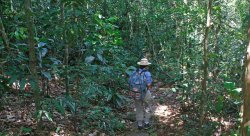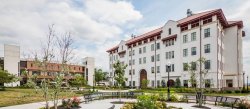March 2, 2018
Technology connects a laboratory island of Panama with the academy of the world
The island, which is part of the Barro Colorado National Monument, was previously an elevation of 171 meters, but it lost almost 30 meters when the waters of the Chagres River were dammed and the artificial lake Gatún was formed, feeding the interoceanic waterway.
Posted in: PRISM

In the middle of the narrow waist that divides the two slopes of the Panama Canal is the island Barro Colorado , which houses one of the most studied forests in the world thanks to a videoconference program that takes that jungle to the classrooms of universities on three continents.
The island, which is part of the Barro Colorado National Monument, was previously an elevation of 171 meters but it lost almost 30 meters when the waters of the Chagres River were dammed and the artificial lake Gatún was formed, which feeds the interoceanic way.
READ ALSO: President Varela meets with His Highness Mohammed bin Zayed Al-Nahyan
Unraveling how a plot of just 1.5 hectares concentrates what experts consider a large number of species is one of the main objectives of the scientists of the Smithsonian Tropical Research Institute (STRI, in its acronym in English), responsible for the area since 1946
Advertising
And in that context and with the goal of strengthening the environmental awareness of the student segment, the couple, Jacalyn Giacalone and Greg Willis, created the "Rainforest Connection" program in 2002.
The program consists of a series of live videoconferences from Panama with schools in America and Asia in order to publicize the long-term studies of tropical mammals such as ñeques, raccoons, tayras and the tapir.
The project representative and science and mathematics educator at Montclair State University, Anna Mazzaro, told Acan-Efe that the idea is to bring the rainforest to the classroom and motivate the students to interact with questions.
"’What would happen if …’ So are the majority of questions asked by students from other parts of the world about what happens in the living laboratory of the Smithsonian in Panama Their curiosity goes further and they question the possible effects on their countries of the changes that occur in that area, "said the scientist.
To complement the classes through videos with the presence of the scientists, the instructors show the live fauna and other images of the forest.
Mazzaro said that with the program that promotes the use of Information and Communication Technologies (ICT), more than 1,000 students from schools in Australia, Belize, Bhutan, Costa Rica, Honduras, New Zealand, Panama and Thailand have benefited.
On the island of Barro Colorado, dedicated exclusively to research, projects are developed involving the most famous universities in the world, and is open to the public with a program of field visits that promote knowledge and conservation of the place.
Established as a biological reserve in 1923, it houses more than 1,300 different species of plants, 335 of birds, 35 of amphibians, 75 of reptiles and thousands of arachnids and insects.
There is also a census of Mammals, which began in 1982 to evaluate the changes and behavior of the animals and carries until now a record of 35 terrestrial species, including more than one million photos within Barro Colorado.
Teacher Mazzaro is worried about the speed at which tropical forests are lost, while Dr. Giacalone Willis has the urge to inform students questions that will help them make smart decisions in the future.
"Sometimes students are surrounded by so much technology that they forget the natural part, the more we involve them and give them the tools to know the importance of nature, I think that will be an achievement," said Mazzaro.
On the other hand, Giacalone said that they are going through a shortage of funds to maintain the academic program, but she and the other researchers do not give up trying to spread the message of what happens in one of the research stations of tropical biology more ancient and active of the world.
Article by Critica
